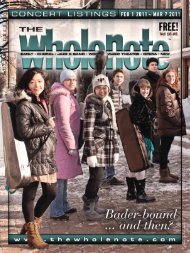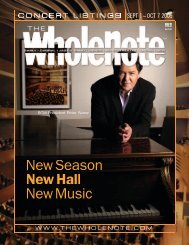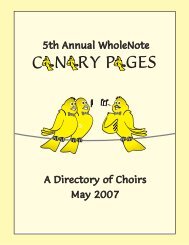Create successful ePaper yourself
Turn your PDF publications into a flip-book with our unique Google optimized e-Paper software.
Beat by Beat | Jazz Notes‘Those LazyHazy Crazy Daysof Summer’Jim GallowayFirst of all, just in case you read last month’s column and arewondering how my adventure in Vienna ended, I am out of thewoods, so to speak, and back home safe and relatively sound. <strong>The</strong>last leg — no pun intended — was a direct flight from Vienna to Torontobringing to a close a trip to remember.I was allowed out of the infirmary a good deal less infirm thanwhen I went in but had to wait a few days before I could get the flighthome and so I spent the night before I left at Jazzland where I enjoyeda lovely evening listening to guitarist Mundell Lowe.Lowe is not a household name in jazz but he is oneof the truly importantnames in the world ofjazz guitarists.<strong>The</strong>re are guitar playerswho have relatively highprofiles throughouttheir careers — BarneyKessell, Bucky Pizzarelli,Charlie Christian, EdBickert, Eddie Lang, HerbEllis, Jim Hall, Joe Pass,John McLaughlin, John Scofield, Kenny Burrell, Pat Martino and PatMetheny are a few of those who attained that recognition.<strong>The</strong>n there are those who opted for a life largely spent in studios orin rhythm sections of big bands or as sidemen — Barry Galbraith, CarlKress, Eddie Durham, George Van Eps, Joe Puma and Mundell Lowe fitthat description.Now here’s the thing about Mundell: he still sounds great, bothplaying and verbalizing — we had a most enjoyable conversation andhis first question was, “How’s Ed?” as in Bickert. He knew that Ed hadstopped playing, but simply wanted to know how he is.I suspect Mr. Bickert has no idea just how highly regarded he is inthe international jazz community.But more on the subject of Mundell Lowe.In the 50s and 60s he worked in New York with the NBC and CBSorchestras and on the Today Show studio band. He then moved toCalifornia and met Jackie Cooper, the famous child actor turned executivewho at the time was head of Screen Gems. As a point of interest,at age nine Cooper was also the youngest performer to have beennominated for an Academy Award as best actor for the film Skippy in1931. Mundell got work composing for a number of the Screen GemsTV and film projects but eventually was frustrated by the fact that hewas doing more writing than playing and so in the 80s he turned backto his first love — playing. A sampling of the artists with whom he hasplayed includes Billie Holiday, Lester Young, Charlie Parker, HelenHumes, Charles Mingus, Sarah Vaughan, Carmen McRae, Benny Carterand Stan Getz — and he is still going strong.Oh, and one thing I should mention is that Mundell Lowe is 91years young!Other musicians who lived long and active lives and hit the 90mark include Eubie Blake, Dave Brubeck, Benny Carter, Jay McShannand Artie Shaw.Speaking of longevity, how many of you know the name AlGallodoro? Not many, I would bet, and yet among musicians — andsome of the names may surprise you — he is held in high esteem –Jimmy Dorsey — “the best saxophone player that ever lived!”Buddy DeFranco — “Art Tatum, Charlie Parker, Heifetz, Perlman andGallodoro are unequalled and may be for years to come.”Benny Golson —“Amazing! <strong>The</strong> world should know Al Gallodoro.He is a hero in my eyes and in the eyes of the many others whoknow him.”He was an American clarinetist and saxophonist who performedfrom the 1920s up until his death at age 95 and played with IshamJones, lead alto sax with the Paul Whiteman Orchestra and bassclarinet in the NBC Symphony Orchestra under Arturo Toscanini.In 1945 Warner Brothers made a movie very loosely based on thelife of George Gershwin called Rhapsody in Blue and it features thefamous opening clarinet glissando.Well, that was Al Gallodoro.He was much in demand as a studio musician throughout hiscareer and in 1958 Ferde Grofé composed Gallodoro’s Serenadefor Saxophone and Piano but today he is one of the largelyforgotten heroes.But for every musician who made it into their 90s there were toomany who didn’t even see 30.Bubber Miley died of tuberculosis in 1932 at the age of 29, as didFats Navarro in 1950 at the age of 26 and Charlie Christian in 1942 atthe age of 25. Clifford Brown died in a car crash in 1956 at the age of25 and alcoholism claimed Bix Beiderbecke in 1931 at the age of 28.Mention of Beiderbecke reminds me of a story that Wild BillDavison, the fiery cornet player from Defiance,Ohio — he could not have come from a more aptlynamed town — told meabout the days of prohibition,through which hedrank his way consumingwhatever might be available.He explained thatduring prohibitionmusicians loved to playDetroit, where there wasa very popular speakeasywhich was the destinationafter the gig for a lot of residentand travelling jazzers and where he would sometimes hang with Bix.What made Detroit such a haven for drinkers was the fact that justacross the Detroit River was Windsor where there was no prohibition.<strong>The</strong> speakeasy that Bill was talking about solved their problem byhaving cases of booze loaded on the Canadian side onto a sort of raftwhich was then hauled, not over the river, but under it on the riverbedto avoid detection by the authorities! Some nights the customerswould arrive at the booze can before the shipment, but as Bill said, “Itwas worth the wait to get that real Scotch.”Midsummer Nights (and Days)<strong>The</strong> summer stretches out ahead of us with its usual crop of festivalsfirmly establishing the fact that straight ahead jazz musicians, withfew exceptions, can no longer fill a large concert hall or marquee andmore and more the real jazz is to be found in smaller venues.Toronto audiences have long memories and with Roy ThomsonHall, Massey and Koerner Hall presenting on a year-round basis atleast some of the few “name” jazz groups it makes it a gamble to bringthem back too soon, thus reducing the number of “stars” available atfestival time.Is it possible that the days of big-time jazz festivals which rely onnon-jazz acts in order to sell tickets and satisfy sponsors are drawingto a close? Is it perhaps time to call them music festivals sinceobviously a real jazz festival, which hardly exists any more, shouldnot even try to compete with concert hall programming? Calling ita music festival would still attract the jazz fans to the jazz content ofthe festival and defuse the criticism of non-jazz acts. Sponsors, whoare primarily interested in having presence in the community wouldstill be happy and I’m sure wouldn’t mind if they changed the name.It’s as close to a win-win scenario as I can come up with, at least forthe moment.Getting back to the value of less being more, my own experience32 | June 7 – September 7, 2013 thewholenote.com
















